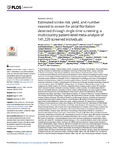Mostrar o rexistro simple do ítem
Estimated stroke risk, yield, and number needed to screen for atrial fibrillation detected through single time screening: a multicountry patient-level meta-analysis of 141,220 screened individuals.
| dc.contributor.author | Lowres, Nicole | |
| dc.contributor.author | Olivier, Jake | |
| dc.contributor.author | Chao, Tze-Fan | |
| dc.contributor.author | Chen, Shih-Ann | |
| dc.contributor.author | Chen, Yi | |
| dc.contributor.author | Diederichsen, Axel | |
| dc.contributor.author | Fitzmaurice, David A. | |
| dc.contributor.author | Gómez Doblas, Juan José | |
| dc.contributor.author | Harbison, Joseph | |
| dc.contributor.author | Healey, Jeff S. | |
| dc.contributor.author | Hobbs, F. D. Richard | |
| dc.contributor.author | Kaasenbrood, Femke | |
| dc.contributor.author | Keen, William | |
| dc.contributor.author | Lee, Vivian W. | |
| dc.contributor.author | Lindholt, Jes S. | |
| dc.contributor.author | Lip, Gregory | |
| dc.contributor.author | Mairesse, Georges H. | |
| dc.contributor.author | Mant, Jonathan | |
| dc.contributor.author | Martin, Julie W. | |
| dc.contributor.author | Martín-Rioboo, Enrique | |
| dc.contributor.author | McManus, David D. | |
| dc.contributor.author | Muñiz, Javier | |
| dc.contributor.author | MünzelI, Thomas | |
| dc.contributor.author | Nakamya, Juliet | |
| dc.contributor.author | Neubeck, Lis | |
| dc.contributor.author | Quinn, F. Russell | |
| dc.contributor.author | Roalfe, Andrea K. | |
| dc.contributor.author | Sandhu, Roopinder K. | |
| dc.contributor.author | Schnabel, Renate B. | |
| dc.contributor.author | Smyth, Breda | |
| dc.contributor.author | Soni, Apurv | |
| dc.contributor.author | Tieleman, Robert | |
| dc.contributor.author | Wang, Jiguang | |
| dc.contributor.author | Wild, Philipp S. | |
| dc.contributor.author | Yan, Bryan P. | |
| dc.contributor.author | Freedman, Ben | |
| dc.date.accessioned | 2019-12-09T13:20:56Z | |
| dc.date.available | 2019-12-09T13:20:56Z | |
| dc.date.issued | 2019-09-25 | |
| dc.identifier.citation | Lowres N, Olivier J, Chao T-F, Chen S-A, Chen Y, Diederichsen A, et al. Estimated stroke risk, yield, and number needed to screen for atrial fibrillation detected through single time screening: a multicountry patient-level meta-analysis of 141,220 screened individuals. PLoS Med. 2019; 16(9): e1002903. doi.org/10.1371/journal.pmed.1002903 | es_ES |
| dc.identifier.issn | 1549-1676 | |
| dc.identifier.uri | http://hdl.handle.net/2183/24447 | |
| dc.description.abstract | [Abstract] Background. The precise age distribution and calculated stroke risk of screen-detected atrial fibrillation (AF) is not known. Therefore, it is not possible to determine the number needed to screen (NNS) to identify one treatable new AF case (NNS-Rx) (i.e., Class-1 oral anticoagulation [OAC] treatment recommendation) in each age stratum. If the NNS-Rx is known for each age stratum, precise cost-effectiveness and sensitivity simulations can be performed based on the age distribution of the population/region to be screened. Such calculations are required by national authorities and organisations responsible for health system budgets to determine the best age cutoffs for screening programs and decide whether programs of screening should be funded. Therefore, we aimed to determine the exact yield and calculated stroke-risk profile of screen-detected AF and NNS-Rx in 5-year age strata. Methods and findings. A systematic review of Medline, Pubmed, and Embase was performed (January 2007 to February 2018), and AF-SCREEN international collaboration members were contacted to identify additional studies. Twenty-four eligible studies were identified that performed a single time point screen for AF in a general ambulant population, including people ≥65 years. Authors from eligible studies were invited to collaborate and share patient-level data. Statistical analysis was performed using random effects logistic regression for AF detection rate, and Poisson regression modelling for CHA2DS2-VASc scores. Nineteen studies (14 countries from a mix of low- to middle- and high-income countries) collaborated, with 141,220 participants screened and 1,539 new AF cases. Pooled yield of screening was greater in males across all age strata. The age/sex-adjusted detection rate for screen-detected AF in ≥65-year-olds was 1.44% (95% CI, 1.13%–1.82%) and 0.41% (95% CI, 0.31%–0.53%) for <65-year-olds. New AF detection rate increased progressively with age from 0.34% (<60 years) to 2.73% (≥85 years). Neither the choice of screening methodology or device, the geographical region, nor the screening setting influenced the detection rate of AF. Mean CHA2DS2-VASc scores (n = 1,369) increased with age from 1.1 (<60 years) to 3.9 (≥85 years); 72% of ≥65 years had ≥1 additional stroke risk factor other than age/sex. All new AF ≥75 years and 66% between 65 and 74 years had a Class-1 OAC recommendation. The NNS-Rx is 83 for ≥65 years, 926 for 60–64 years; and 1,089 for <60 years. The main limitation of this study is there are insufficient data on sociodemographic variables of the populations and possible ascertainment biases to explain the variance in the samples. Conclusions. People with screen-detected AF are at elevated calculated stroke risk: above age 65, the majority have a Class-1 OAC recommendation for stroke prevention, and >70% have ≥1 additional stroke risk factor other than age/sex. Our data, based on the largest number of screen-detected AF collected to date, show the precise relationship between yield and estimated stroke risk profile with age, and strong dependence for NNS-RX on the age distribution of the population to be screened: essential information for precise cost-effectiveness calculations. | es_ES |
| dc.language.iso | eng | es_ES |
| dc.publisher | Public Library of Science (PLoS) | es_ES |
| dc.relation.uri | https://doi.org/10.1371/journal.pmed.1002903 | es_ES |
| dc.rights | Atribución 3.0 España | es_ES |
| dc.rights.uri | http://creativecommons.org/licenses/by/3.0/es/ | * |
| dc.title | Estimated stroke risk, yield, and number needed to screen for atrial fibrillation detected through single time screening: a multicountry patient-level meta-analysis of 141,220 screened individuals. | es_ES |
| dc.type | info:eu-repo/semantics/article | es_ES |
| dc.rights.access | info:eu-repo/semantics/openAccess | es_ES |
| UDC.journalTitle | PLOS Medicine | es_ES |
| UDC.volume | 16 | es_ES |
| UDC.issue | 9 | es_ES |
| UDC.startPage | e1002903. | es_ES |
Ficheiros no ítem
Este ítem aparece na(s) seguinte(s) colección(s)
-
GI- GRINCAR - Artigos [203]






